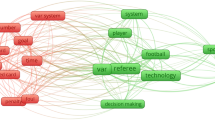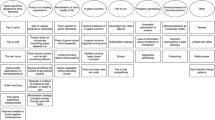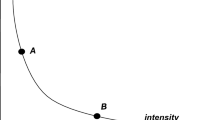Abstract
This study empirically investigates the revenue return to differential seat pricing in the Korean movie theater market and how it is affected by competition. In March 2016, one of three major multiplex chains in the market divided the seats in most of its screening auditoria into prime (high-quality), standard (medium-quality), and economy (low-quality) zones, and started charging different prices for each seating zone. For the analysis, we construct a unique dataset that contains ticket prices and the number of tickets that are sold at the show level. We find that differential seat pricing increases revenue on average by 10.6%, but does not affect the number of tickets sold. Based on the results, we suggest that in a situation in which a large number of seats remain unsold, the pricing scheme involves encouraging the sale of the prime zone seats by increasing their price only slightly. By measuring the degree of competition as the number of showings of the same movie that are played by neighboring theaters at a similar time, we also find that competition has a small negative effect on the revenue gain from differential seat pricing. This finding may be explained by switching costs that are due to moviegoers’ being away from preferred theater locations and showtimes.

Similar content being viewed by others
Notes
In the entertainment industry, the practice of differential seat pricing is known as “scaling the house.”
Note that differential seat pricing in a movie theater is a good example of second-degree price discrimination, since it is difficult to explain observed price differences across seating zones by the costs of providing seat quality.
They are vertically integrated with distributors, CJ E&M, Lotte Entertainment, and Megabox Plus M, respectively.
There are a few seats that do not fall into any of the three seating zones such as seats for wheelchairs and couples.
When differential seat pricing was introduced, the three multiplex chains were already engaging in price discrimination based on time slots (such as day-of-the-week and/or time-of-day).
For a show that played in a premium auditorium on December 23, its ticket price was 80,000 KRW, and all 226 seats were sold out.
A premium auditorium is designed to offer a better movie-watching experience (e.g., a customized curved screen, fully-reclining chairs, advanced quality sound).
The capacity utilization of each seating zone is the ratio of occupied seats in each zone to total seats.
In 2016, the penetration rate of cellphones in Korea was 122.7% (Statistics Korea).
Loyalty programs for CGV, Lotte Cinema, and Megabox are CJ ONE, L.POINT, and Megabox membership, respectively.
The magnitude of our estimated elasticity is similar to that in Canterbery and Marvasti (2001), who find that the price elasticity of movie demand ranges from \(-\)0.23 to \(-\)0.51 using 1965–1991 time-series data for the U.S. movie industry. The authors regard such inelasticity as a measure of the success of the major studios in differentiating their products through non-price competition.
In their field experiment, Dubé et al. (2017) find almost no substitution between two competing theaters, which is consistent with strong idiosyncratic preference for a specific theater. In addition, according to the authors, industry practitioners do not believe that most evening moviegoers would substitute for a show before noon.
As noted in Subsect. 3.2, the average capacity utilization of the U.S., Canadian, and German movie theater markets is about 20%, 22%, and 12.3%, respectively.
Similar figures are obtained for other random samples.
As shown in Table 1, 40.7% of total seats in an auditorium are assigned to the prime zone on average. Thus, in shows with less than the capacity utilization of 40%, opportunistic behavior of economy zone ticket holders is possible.
References
Abraham, J. M., Gaynor, M., & Vogt, W. B. (2007). Entry and competition in local hospital markets. Journal of Industrial Economics, 55, 265–288.
Armstrong, M., & Vickers, J. (2001). Competitive price discrimination. RAND Journal of Economics, 32, 579–605.
Böhme, E., & Müller, C. (2011). Searching for the concentration-price effect in the German movie theater industry. Jahrbücher für Nationalökonomie und Statistik, 231, 479–493.
Borenstein, S. (1985). Price discrimination in free-entry markets. RAND Journal of Economics, 16, 380–397.
Borenstein, S., & Rose, N. L. (1994). Competition and price dispersion in the US airline industry. Journal of Political Economy, 102, 653–683.
Busse, M., & Rysman, M. (2005). Competition and price discrimination in yellow pages advertising. RAND Journal of Economics, 36, 378–390.
Canterbery, E. R., & Marvasti, A. (2001). The US motion pictures industry: An empirical approach. Review of Industrial Organization, 19, 81–98.
Chandra, A., & Lederman, M. (2018). Revisiting the relationship between competition and price discrimination. American Economic Journal: Microeconomics, 10, 190–224.
Cheung, S. N. (1977). Why are better seats “Underpriced’’? Economic Inquiry, 15, 513–522.
Chisholm, D. C., & Norman, G. (2012). Spatial competition and market share: An application to motion pictures. Journal of Cultural Economics, 36, 207–225.
Courty, P. (2011). Unpriced quality. Economics Letters, 111, 13–15.
Courty, P., & Pagliero, M. (2012). The impact of price discrimination on revenue: Evidence from the concert industry. Review of Economics and Statistics, 94, 359–369.
Dahl, G., & DellaVigna, S. (2009). Does movie violence increase violent crime? Quarterly Journal of Economics, 124, 677–734.
Dai, M., Liu, Q., & Serfes, K. (2014). Is the effect of competition on price dispersion nonmonotonic? Evidence from the us airline industry. Review of Economics and Statistics, 96, 161–170.
Davis, P. (2005). The effect of local competition on admission prices in the US motion picture exhibition market. Journal of Law and Economics, 48, 677–707.
Davis, P. (2006a). Measuring the business stealing, cannibalization and market expansion effects of entry in the US motion picture exhibition market. Journal of Industrial Economics, 54, 293–321.
Davis, P. (2006b). Spatial competition in retail markets: Movie theaters. The RAND Journal of Economics, 37, 964–982.
de Roos, N., & McKenzie, J. (2014). Cheap Tuesdays and the demand for cinema. International Journal of Industrial Organization, 33, 93–109.
Dubé, J.-P., Fang, Z., Fong, N., & Luo, X. (2017). Competitive price targeting with smartphone coupons. Marketing Science, 36, 944–975.
Eckard, E. W., & Smith, M. A. (2012). The revenue gains from multi-tier ticket pricing: Evidence from Pop music concerts. Managerial and Decision Economics, 33, 463–473.
Einav, L. (2007). Seasonality in the US motion picture industry. Rand Journal of Economics, 38, 127–145.
Gerardi, K. S., & Shapiro, A. H. (2009). Does competition reduce price dispersion? New evidence from the airline industry. Journal of Political Economy, 117, 1–37.
Ho, J. Y., Liang, Y. S., Weinberg, C. B., & Yan, J. (2018). An empirical study of uniform and differential pricing in the movie theatrical market. Journal of Marketing Research, 55, 414–431.
Holmes, T. J. (1989). The effects of third-degree price discrimination in oligopoly. American Economic Review, 79, 244–250.
Huntington, P. A. (1993). Ticket pricing policy and box office revenue. Journal of Cultural Economics, 17, 71–87.
KOFIC. (2015). 2014 Movie Consumer Survey. Busan: Korean Film Council.
KOFIC. (2017). 2016 Movie Consumer Survey. Busan: Korean Film Council.
KOFIC. (2020). 2019 Korean Film Industry Report. Busan: Korean Film Council.
Leslie, P. (2004). Price discrimination in Broadway theater. RAND Journal of Economics, 35, 520–541.
Levitt, S. D., List, J. A., Neckermann, S., & Nelson, D. (2016). Quantity discounts on a virtual good: The results of a massive pricing experiment at King Digital Entertainment. Proceedings of the National Academy of Sciences, 113, 7323–7328.
Lin, H., & Wang, I. Y. (2015). Competition and price discrimination: Evidence from the parking garage industry. Journal of Industrial Economics, 63, 522–548.
Liu, Y. (2006). Word of mouth for movies: Its dynamics and impact on box office revenue. Journal of Marketing, 70, 74–89.
Mazzeo, M. J. (2002). Product choice and oligopoly market structure. RAND Journal of Economics, 33, 221–242.
Moretti, E. (2011). Social learning and peer effects in consumption: Evidence from movie sales. Review of Economic Studies, 78, 356–393.
Moul, C. C. (2007). Measuring word of mouth’s impact on theatrical movie admissions. Journal of Economics & Management Strategy, 16, 859–892.
Orbach, B. Y., & Einav, L. (2007). Uniform prices for differentiated goods: The case of the movie-theater industry. International Review of Law and Economics, 27, 129–153.
Rochet, J.-C., & Stole, L. A. (2002). Nonlinear pricing with random participation. Review of Economic Studies, 69, 277–311.
Seim, K., & Viard, V. B. (2011). The effect of market structure on cellular technology adoption and pricing. American Economic Journal: Microeconomics, 3, 221–51.
Shiller, B., & Waldfogel, J. (2011). Music for a song: An empirical look at uniform pricing and its alternatives. Journal of Industrial Economics, 59, 630–660.
Stavins, J. (2001). Price discrimination in the airline market: The effect of market concentration. Review of Economics and Statistics, 83, 200–202.
Stole, L. A. (1995). Nonlinear pricing and oligopoly. Journal of Economics & Management Strategy, 4, 529–562.
Sunada, M. (2012). Competition among movie theaters: An empirical investigation of the Toho–Subaru antitrust case. Journal of Cultural Economics, 36, 179–206.
Yang, H., & Ye, L. (2008). Nonlinear pricing, market coverage, and competition. Theoretical Economics, 3, 123–153.
Author information
Authors and Affiliations
Corresponding author
Additional information
Publisher's Note
Springer Nature remains neutral with regard to jurisdictional claims in published maps and institutional affiliations.
The authors thank seminar participants at the Bass FORMS Conference 2021, the INFORMS Marketing Science Conference 2018, University of Maryland, and Sogang University for their helpful comments and suggestions.
Rights and permissions
Springer Nature or its licensor (e.g. a society or other partner) holds exclusive rights to this article under a publishing agreement with the author(s) or other rightsholder(s); author self-archiving of the accepted manuscript version of this article is solely governed by the terms of such publishing agreement and applicable law.
About this article
Cite this article
Yi, G., Kim, M. & Chung, H.S. The Revenue Impact of Differential Seat Pricing and Competition in the Movie Theater Market. Rev Ind Organ 64, 361–382 (2024). https://doi.org/10.1007/s11151-024-09944-2
Published:
Issue Date:
DOI: https://doi.org/10.1007/s11151-024-09944-2




